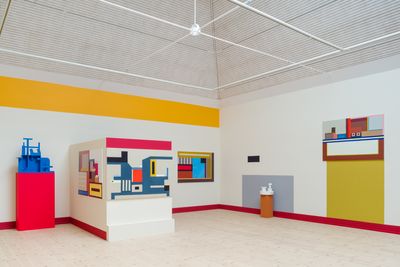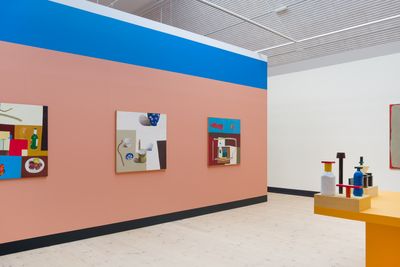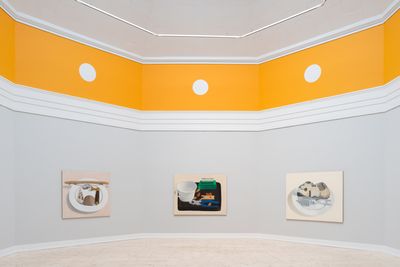Nathalie Du Pasquierpaintings of things. paintings as objects
–
–
Nathalie Du Pasquier is a French visual artist who began her career as a designer in Milan, Italy. This exhibition – which marks the first time she has been hosted in a visual arts institution in Denmark, and indeed Scandinavia – brings together a selection of her artworks at Kunsthal Aarhus. Realised between 1989 and the present day, they trace an ongoing, experimental process in which Du Pasquier investigates and revisits the genre of still-life painting. Thus, the exhibition grants viewers access to her versatile approach towards painting and sculpture.
Her journey as a self-taught artist and designer began in 1975. She travelled extensively during this time, particularly in Africa, and this experience informed her later work. At the end of the 1970s she moved to Milan, and in 1981 she helped to establish – and became a prominent member of – the Memphis Group. This was an experimental, post-modern design collective that looked beyond the architectural field to remix architectural and artistic movements across distant periods and geographies – such as Art Deco and Pop Art – creating uniquely fabricated furniture, fabrics, carpets, and ceramics. Du Pasquier was responsible for the patterned surfaces that are characteristic of its kitschy, yet elegant, style, and was a member until the group was disbanded in 1987. Since then, she has dedicated her time to creating pictures that can exist as autonomous paintings and free-standing objects, or otherwise become elements of large spatial environments. In 2016, Du Pasquier’s distinctive colourful compositions and impossible abstract structures were rediscovered by a wider, international audience as a result of her breakthrough solo exhibition at Kunsthalle Wien, Austria.
About the Exhibition
Three galleries in the oldest spaces of Kunsthal Aarhus are dotted with sixty-two artworks. As the full stop of the exhibition title emphasises, they are clustered in the dusk and dawn of two specific periods defining the artist´s career: 1989 --> 2000 and 2015 --> 2023: these symbolise two key phases during which Du Pasquier developed her iconic artistic style. To bridge the temporal gap, Gallery 2 hosts a series of ceramics (PASQUI, 2002) assembled using casts made of scrap wood and plastic objects, such as a water bottle and a filter basket for a coffee maker. They were realised in collaboration with the experimental CRAFT laboratory in Limoges, France, a city that is known worldwide for its porcelain industry. These ceramics sit ambiguously between the realms of representation and abstraction. At first glance, they are abstract constructions, but under closer examination they become recognisable as imaginary and futuristic urban landscapes.
1989 --> 2000: paintings of things
Galleries 2 and 3 focus on Du Pasquier’s earlier, figurative artworks: those which the artist calls paintings of things. They consist of pictures that follow an accurate compositional method, yet they are imbued with spontaneous intuition. In 1987, when painting became Du Pasquier’s focus, still-lifes became her preferred genre. In the works, she uses an earthenware colour palette – applied using thin layers of brushwork – on squared canvasses, as well as large sheets of paper. They portray, in meticulous detail, what the artist finds in front of her – a piece of fruit, a vase, a chair – next to items of “bric-à-brac”: universal and rudimentary “things” such a screwdriver, or washing power in a cardboard box.
These things are accompanied by imaginary living forms – a stone, a seashell, a bird, a dog – drawn from personal memories, such as Untitled (1995), and deliberately oversized. In some pictures, they converge inside a circular or square enclosure – a dinner plate, a breadbasket, or a fence – a painted frame which intentionally doubles up the physical frame of the canvas. The manner in which the artist arranges these subjects may act as a record of daily events and activities, but it also seems to signify an unspoken language in the way that African wax prints – familiar to the artist as a result of her time travelling and designing textiles – encode specific meanings.
Organising the background of her compositions and scattering things around over chequered tablecloths (Le rose della portinaia (The Roses of the Concierge, 1993), Du Pasquier uses a grid to order three-dimensional objects in two-dimensional space. In this, we can observe the foundations of the artist´s later abstract phase, where geometric patterns explode and expand.
2015 --> 2023: paintings as objects
Gallery 1 marks a shift in the way Du Pasquier approaches the genre of still-life painting. It no longer seeks to imitate nature: instead, her paintings focus on abstract geometries that have become the main subject. Grids, lines, colours, and proportions become universal expressive tools used in an endless process, where variations emerge one after the other from the reworking of older compositions. By moving onto a larger physical domain, the artist shifts our attention from the realm of the image to that of the object.
A play on scale takes centre stage now. It is as if the artist put a magnifying lens on her earlier works, blowing up all life-like figures and details out of proportion, distorting them to the extent they can no longer be distinguished. Such a method is – once again – reminiscent of the patterned prints of African wax textiles, where the motifs are pulled from reality and turned into flattened out geometric shapes floating in space. It also pays homage to the isometric aesthetics of axonometric projections, a technique used in the fields of architecture and design to draw something that is solid and three-dimensional – objects, building exteriors, or spatial interiors – in a two-dimensional space.
Du Pasquier’s canvases now expand onto their surroundings, connecting to physical structures like a table, or an enclosed cabin. The explosive colours of each individual canvas playfully overlap with the saturated surfaces of the interiors in which they are displayed, paving the way for immersive visual experiences. Our perception is intrigued by the blurred lines between artwork and staging, wavering between the two-dimensionality of the picture and the three-dimensionality of the space surrounding it. This approach is put to use in a wall-painting commissioned by Kunsthal Aarhus, in which the artist incorporates the architecture of the café and entrance into her exhibition.
About the Artist
Nathalie Du Pasquier (b. 1957, Bordeaux, France) lives and works in Milan since 1979. Until 1986 she worked as a designer and was a founding member of the post-modern design collective Memphis Group, for which she designed numerous “decorated surfaces”: textiles, carpets, plastic laminates, and some furniture and objects. In 1987 she turned the focus of her practice to painting. Her distinctive colourful compositions and abstract structures have been rediscovered by a wider, international audience as a result of her breakthrough solo exhibition at Kunsthalle Wien (Vienna, 2016). She has exhibited in international group exhibitions at, among others, Museum Haus Konstruktiv, Zurich (Geometric Opulence, 2022); Palais de Tokyo, Paris (Future, Former, Fugitive: A French Scene, 2019); Le Consortium, Dijon (3rd Biennale l'Almanach18, 2018) and Museo José Luis Cuevas, Ciudad de México (Lecciones de Tinieblas, 2007). Her work has been the subject of solo exhibitions at Institute of Contemporary Art (Philadelphia, 2017); MACRO — Museum of Contemporary Art (Rome, 2021); MRAC – Musée régional d’art contemporain (Sérignan, 2022); GfZK – Museum of Contemporary Art (Leipzig, 2019), MGLC – The International Centre of Graphic Arts (Ljubljana, 2019) and Camden Arts Centre (London, 2017), among others.
The exhibition is supported by:
Danish Arts Foundation
Aarhus Municipality
Augustinusfonden
Beckett-Fonden
Knud Højgaards Fond
Institut français du Danemark
Curator: Diana Baldon.
Co-curator: Seolhui Lee.




